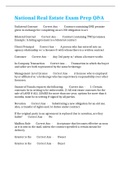Summary
Summary Psychology Chapter 22 Notes - Substance abuse and psychopharmacology
Psychology notes based on the textbook "Psychology and introduction" the 4th edition by L. Swartz, C. De la Rey, N. Duncan, L Townsend, Vivien O'Neill. This document is about the topic of Substance abuse and psychopharmacology.
[Show more]












